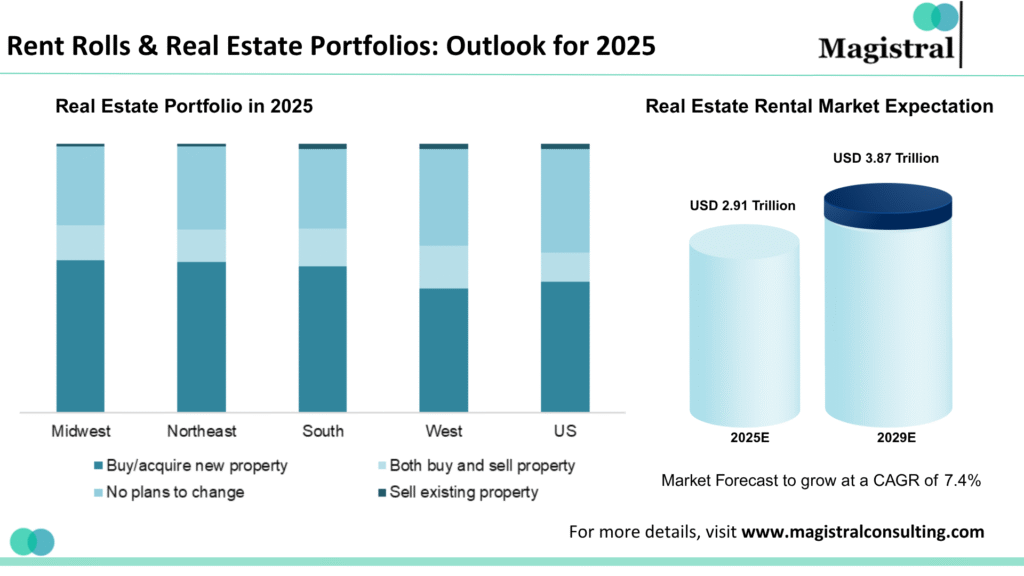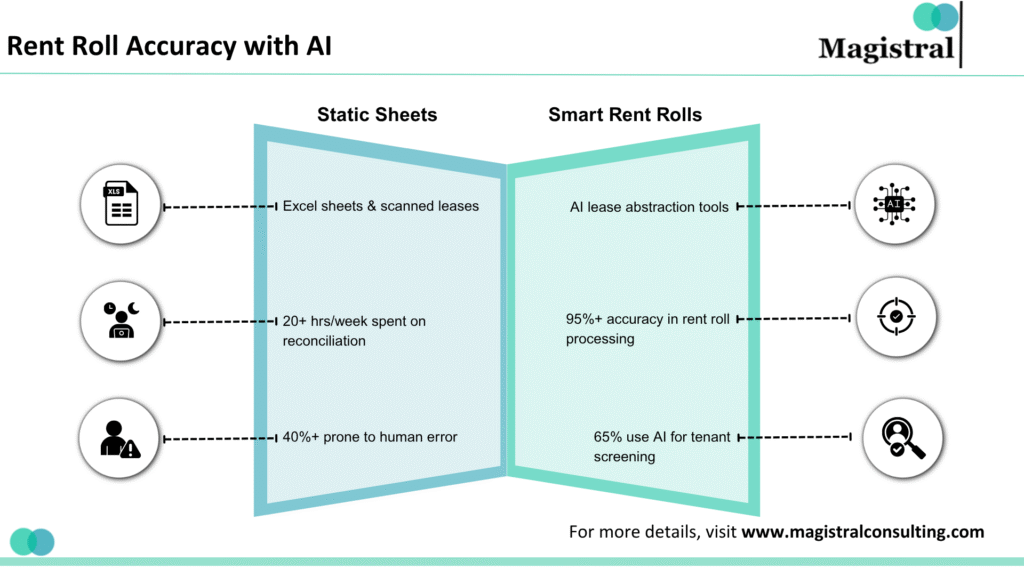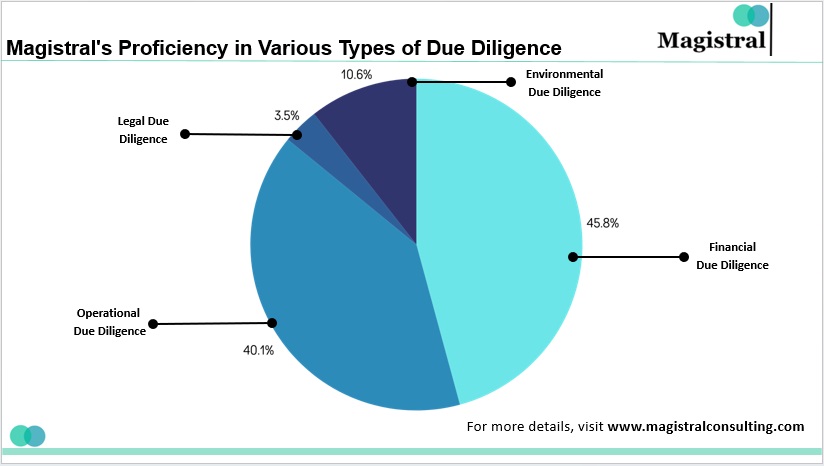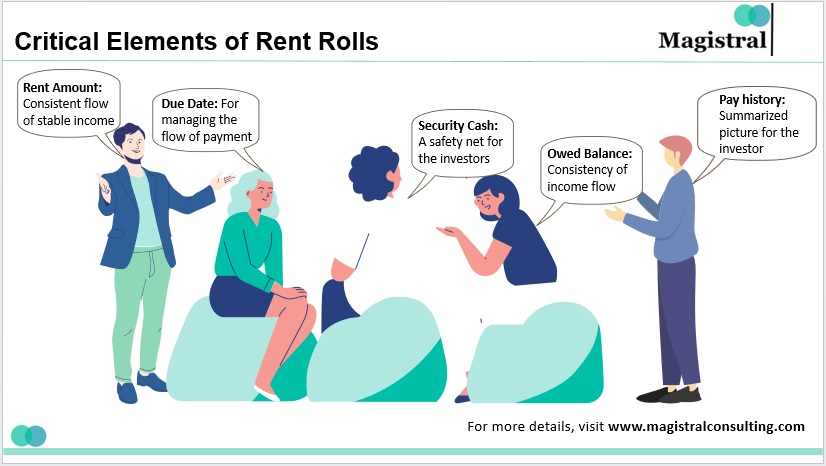In the fast-changing world of renting, rent rolls are not just a record of tenants and lease terms. It is also a strategic tool that describes the income health, operational risk, and future opportunity of a property. As rents continue to increase, tenant expectations are changing, and technology is changing the landscape of property management. Landlords and managers should view rent rolls more strategically and analytically.
Rising operational costs, growing regulatory burdens, and uneven supply trends across U.S. Markets are all influencing how rent rolls are built and interpreted. At the same time, property managers face growing pressure to maintain both profitability and compliance. It is critical to distinguish between a rent roll’s surface-level figures and the true performance they represent.
Rent Roll Checklist for Property Managers
With the U.S. average rent holding steady at $2,100 in 2025 and available rentals nearing 645,000 units, property managers face a unique challenge. It involves balancing growth with quality management. While the year-over-year rent decline of $20 may seem marginal, it signals a flattening market that demands smarter portfolio decisions, not just more doors under management.
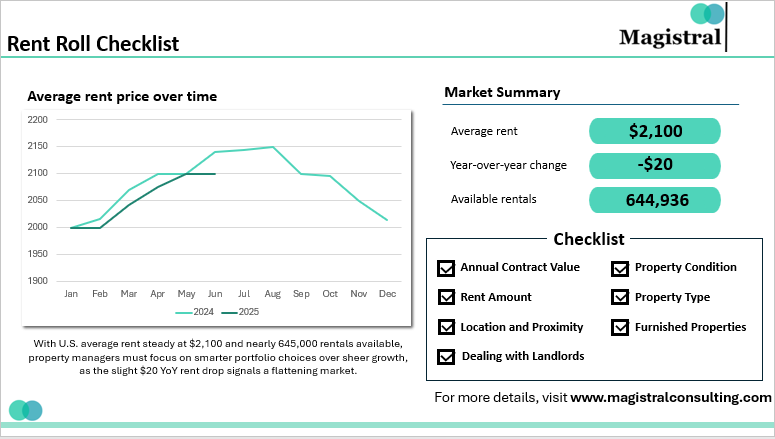
Rent Roll Checklist
Here are seven key tips for rent rolls- grounded in market data and management experience—to help property managers build a resilient, high-performing rent rolls:
Annual Contract Value
According to Darren, you should base your fees on your experience and the results you deliver. Avoid slashing fees too much- set a minimum discount range if needed, but don’t compromise your business’s financial health. How a property owner negotiates fees often reflects what working with them will be like. Owners who argue over fees tend to be more challenging, while those who value your services are usually easier to work with and more aligned with your goals.
Rent Amount
A rent roll should reflect the expected rental income from a property. Darren advises staying away from properties with very low rents. They usually come with low management fees and attract tenants who may bring more issues. Set a minimum rent level and avoid going below that to maintain profitability.
Location and Proximity
Location matters not just for property value but also for management efficiency. Avoid high-crime areas or properties located far from your base, as long travel times mean more costs and time spent. Ideally, most of your managed properties should be nearby to keep operations efficient.
Dealing with Difficult Landlords
Successful property management relies heavily on good relationships with landlords. While tools can help, identifying red flags early, such as landlords who are overly demanding or have unrealistic expectations, can save you headaches later. Watch out for those who resist paying for repairs, expect unreasonably low fees, or have subpar properties with high demands.
Property Condition
Don’t be fooled by surface appearances. The condition of a property- its cleanliness, structure, and maintenance- speaks volumes. New homes aren’t always cheaper to maintain, and older homes aren’t necessarily bad. Always inspect thoroughly and objective
Property Type
Not all property styles are worth managing. Older apartment units, for example, may bring in less rent and more maintenance issues. Unless they are well-maintained and generate good income, it’s often better to avoid them, or at least charge higher management fees to make them worthwhile.
Rent Roll vs. Gross Potential Income
A rent roll provides a snapshot of a property’s actual rental income. While Gross Potential Income (GPI) shows the income the property could produce if it were 100% occupied at the existing market rents – an ideal situation. The reality is that most commercial properties are not 100% leased and have several tenants paying less than market rents due to the lease obligations.
In addition to analyzing the rent roll, reviewing the Trailing Twelve Months (TTM) or Trailing 6 Months (T3) income details will provide a clearer picture of a property’s income performance and also reveal its potential income-generating capabilities.
Due Diligence is Essential When Examining a Project’s Rent Roll
While a rent roll is usually the document most people choose to evaluate the property’s income. It is not always a completely reliable source of information. There can be mistakes—whether innocent or deliberately misleading—in a rent roll that overstated revenues and made the property appear more profitable than it was. That’s why investors need to thoroughly conduct due diligence and ensure that tenants are paying the rents stated. Lenders are doing the same with the rent roll in their underwriting process for commercial real estate loans.
Rent Rolls: 2025 Rental Market Trends
The U.S. rental market in 2025 is changing quickly, influenced by economic conditions, tenant demands, legislation, and technology. Property managers and landlords typically view these changes as not just data points. It also factors that influence how rent rolls are generated, monitored, evaluated, and managed.
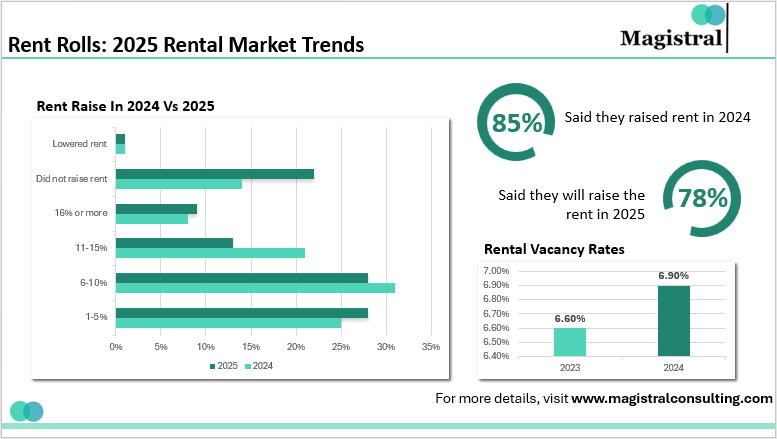
Rent Rolls: 2025 Rental Market Trends
A recent survey by Baselane of over 400 rental property owners provides key themes around some significant changes. Property managers need to be aware of to maintain a healthy rent roll and cost-effective property performance.
Rents Rising to Balance Expenses
In 2024, 85% of landlords raised rents, and 31% of them increased them by 6–10%. Many landlords raised rents primarily to account for extraordinary increases in their operating expenses. Today, property managers can show higher income on rent rolls, but they also still need to ensure rents are appropriately listed and collected.
More Inventory, Rents Still Rising
In Q3 2024, the rental vacancy rates rose to 6.9%, but the average two-bedroom rent increased by 3.2% to $1,906 a month. The continued increase in rents while also raising vacancy rates requires property managers and owners. It is to keep rent roll data in context with local vacancy and market rate trends, or risk altering property performance results.
Tech Adoption Continues, but Costs are the Barrier
Digital technology for rent rolls has entered more in more use. Many rent roll tools are allowing real-time income tracking and automating record-keeping. However, 35% of landlords identify costs as a barrier to adopting digital rent roll tools. Property managers have to weigh upfront cost versus increased long-run efficiency and accuracy.
Single-Family Rentals on the Rise
31% of tenants are renting an SFR, and with a 4.4% increase in YoY rents. 67% of landlords own at least one SFR, and of those who don’t, 32% say they will expand their holdings in SFR in 2025. The reasons for the interest are clear: high rent levels and low turnover, improving the rent roll quality in SFRs.
Increased Legal Regulation Presents New Risk
With new tenant protections legislation, plus a growing number of local governments adding compliance burdens, 17% of landlords consider this the biggest challenge. Rent rolls now include compliance/liability risks and potential expenses, particularly in heavily regulated markets.
Rent Growth and Supply Changes
Overall, the U.S. rental market is still enjoying great rent growth, but it is essentially 2 realities. One where markets have little supply and rents get pushed up, and another where new housing supply construction begins to inform the underlying pricing mechanism. These larger deliveries will offer challenges for property managers and landlords. The challenges will also impact the willingness of a property manager or landlord to keep that historical rent roll information. They also have to maintain it properly, and use it for future decisions.
A recent Baselane survey indicates that 85% of landlords increased rents in 2024, with nearly one-third raising rents by 6%-10%. Furthermore, 78% are looking to raise rents in 2025, at an average of 6.21%. This growth is nearly double the national market average reported by Zillow. As a result, many property rent rolls going into 2025 are based on much higher income projections compared to only a few years ago. That said, if you only relied on those numbers in the rent roll to evaluate property performance and didn’t consider the context you researched on the market level first, then you can see how your projected rents may be fragile based on obstacles at the market level right now. A rent roll may indicate high rental income, but market-level currents can negatively impact your rental income if you aren’t diligent.
Magistral’s Services for Rent Rolls
Magistral Consulting provides a full-service solution for rent roll assessment, management, and optimization. It helps in enabling landlords, real estate investors, and asset owners to make confident decisions based on data. Our service is intended to give an accurate representation of the financial clarity and operational efficiencies of a rental property portfolio.
Rent Roll Preparation and Standardization
Magistral prepares accurate, clean, aligned, and standardized rent rolls for single-property and multiple-property portfolios. This preparation includes summarizing lease term(s), rental amount(s), occupancy status, and rental contract period(s), consistently recorded in accordance with the requirements of industry reporting standards.
Rent Roll Auditing and Reconciliation
We provide rent roll audits by carefully reviewing each entry against the lease agreements, payment records, and bank statements. This ensures the accuracy of previous entries, the identification of any missed payments, and the validation of any reporting errors, particularly at the time of refinance or sale.
Portfolio-Wide Rent Analysis
We analyze rent rolls across portfolios to compare actual rental revenue with market opportunities. We support property owners by identifying assets that are weak performers, evaluating if there are opportunities for revenue improvement, and evaluating the opportunities for rent increases or lease restructuring.
Due Diligence Support for Acquisitions and Dispositions
Magistral supports investors and buyers of real estate by validating rent rolls as part of transaction due diligence. We assess historical income (TTM/T3), highlight risks/issues that may need to be mitigated (e.g., excessive tenant turnover or lease expirations), and provide clarity on the projected cash flow for stability.
About Magistral Consulting
Magistral Consulting has helped multiple funds and companies in outsourcing operations activities. It has service offerings for Private Equity, Venture Capital, Family Offices, Investment Banks, Asset Managers, Hedge Funds, Financial Consultants, Real Estate, REITs, RE funds, Corporates, and Portfolio companies. Its functional expertise is around Deal origination, Deal Execution, Due Diligence, Financial Modelling, Portfolio Management, and Equity Research
For setting up an appointment with a Magistral representative visit www.magistralconsulting.com/contact
About the Author

Prabhash Choudhary is the CEO of Magistral Consulting. He is a Stanford Seed alumnus and mechanical engineer with 20 + years’ leadership at Fortune 500 firms- Accenture Strategy, Deloitte, News Corp, and S&P Global. At Magistral Consulting, he directs global operations and has delivered over $3.5 billion in client impact across finance, research, analytics, and outsourcing. His expertise spans management consulting, investment and strategic research, and operational excellence for 1,200 + clients worldwide
